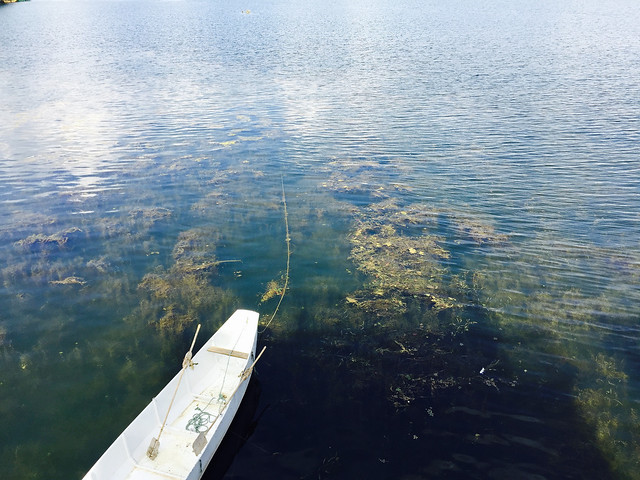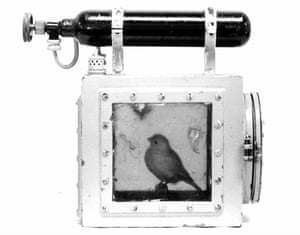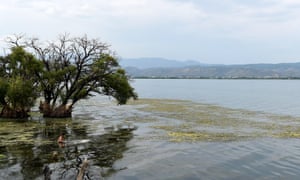http://e-info.org.tw/node/117950
找到生態崩壞關鍵 學者取名「金絲雀物種」籲保育
文字大小
263 3 Share1
本報2016年8月25日綜合外電報導,姜唯編譯;蔡麗伶審校
貓熊、北極熊、黑面琵鷺等「明星物種」往往吸引社會大眾及媒體的目光,甚至成為影響政府決策的利器,不過英國南安普敦大學永續科學系講師戴克(James Dyke)在《衛報》撰文指出,許多為人所忽略的稀有物種消失,其實是生態系統將要崩壞的指標,學界便將這些物種稱為「生態系金絲雀」(ecosystem canaries)。
雲南洱海,是戴克參與的研究監測的案例之一,說明了失去基礎物種的生態系統,被大量的矽藻所佔領,沒有任何其他動植物。圖片來源:Tangqiu(CC BY-NC 2.0)。
除了明星物種 這些生態金絲雀更關鍵
「生態系金絲雀」(ecosystem canaries),緣由是採礦者常用金絲雀偵測地下是否有有毒氣體,而研究指出,生態系統是否健康、具有韌性,可從許多關鍵物種的存在與否看出端倪。也就是說,生態系統受到壓力時,生態金絲雀就是第一個消失的物種。
戴克說,生物多樣性可增加生態系統的韌性;物種越多,每個物種就越能耐受衝擊。生物多樣性就像是飛機上的鉚釘,掉了一兩顆沒事,但掉得越來越多,生態系統功能就會趨向崩壞。
生態金絲雀消失表示生態系統功能有所改變,因此可視為即將崩壞的跡象。
雲南洱海案例 生態系崩壞後難恢復
戴克參與的研究團隊前往中國湖泊,分析矽藻和水生蠓相互競爭資源時的數量變化,歸納出物種的三種型態——繁殖緩慢但是競爭力強的「基石」物種、競爭力弱但是繁殖快速的「雜草」物種,以及繁殖緩慢競爭力也弱的「金絲雀」物種。
這些湖泊的生態系統被農業廢水所污染。當污染情況惡化,金絲雀物種首當其衝。隨著污染越來越嚴重,影響所有的物種,乃至生態系統崩壞,基石物種就會被雜草物種所取代。失去基石物種的生態系統被大量的矽藻所佔領,沒有任何其他動植物。
預防勝於治療,湖泊要變回原本生態豐富的狀態非常困難。
透過觀察基石物種、雜草物種和金絲雀物種的比例,研究人員得以清楚知道一個生態系統多年後,甚至數十年後將崩壞,並有足夠的時間應變,可能是改變農法,或想其他的改善措施。
戴克認為,這個生態理論可應用在其他水生和陸地生態系統。以人類破壞生態的速度和幅度,應有許多驗證這個理論的機會。
【參考資料】
The 'ecosystem canaries' which act as warning signs of collapse
The success or failure of certain species can be used to predict the future health of an entire ecosystem, research says
The Earth’s biodiversity is under attack. We would need to travel back over 65 million years to find rates of species loss as high as we are witnessing today.
Conservation often focuses on the big, enigmatic animals - tigers, polar bears, whales. There are many reasons to want to save these species from extinction. But what about the vast majority of life that we barely notice? The bugs and grubs that can appear or vanish from ecosystems without any apparent impact?
Biodiversity increases resilience: more species means each individual species is better able to withstand impacts. Think of decreasing biodiversity as popping out rivets from an aircraft. A few missing rivets here or there will not cause too much harm. But continuing to remove them threatens a collapse in ecosystem functioning. Forests give way to desert. Coral reefs bleach and then die.
New research that I have been involved in suggests that there biodiversity has a value that has been overlooked, but could be vitally important if we are to manage our impacts on ecosystems. Our study, published in the journal Ecology,shows that crucial information about the overall health or resilience of an ecosystem may be lurking in data about supposedly inconsequential species. In fact, the presence or absence of some of the rarest species may be giving us important clues as to how near an ecosystem is to a potential collapse.
Such rare species we call ecosystem canaries. Like canaries that coal miners used to check for poisonous gasses deep underground, ecosystem canaries are often the first species to disappear from a stressed ecosystem. Their vanishing can be linked to changes in the functioning of ecosystems, which can serve as a warning that a collapse is approaching.
Our study used data collected from lakes in China that showed changes in the abundance of species from algae (diatom) and aquatic midges (chironomid) communities as they compete for resources under environmental pressures. From this data it was possible to identify three types of organism: slowly-replicating but strongly competitive ‘keystone’ species; weakly-competitive but fast-replicating ‘weedy’ species; and slowly-replicating and weakly-competitive ‘canary’ species.
Photo taken in July 2015 shows Erhai Lake in Dali, in southwest China’s Yunnan Province. Yunnan plans to spend 26.4bn yuan (US$4.1bn) to tackle pollution in the Erhai Lake, which saw blooms of blue green algae in 1996 and 2003. Photograph: Lin Yiguang/Xinhua/Alamy
Runoff of fertiliser from surrounding fields has a major environmental impact on these lake ecosystems. As the situation worsens the canary species is the first to suffer.
With continuing degradation affecting all species, this leads to the eventual collapse of the keystone species as they are replaced by the weedy species. The loss of keystones tips the ecosystem into a critical transition – the point at which a system shifts into an alternate state which in lakes is dominated by smothering algae and absence of many plant and animal species. Moving a lake back to a clear water, high biodiversity state can be extremely difficult.Better to avoid the collapse in the first place.
Waiting to observe changes in the keystone species would not allow any intervention because the system would already be spiralling towards collapse. By searching for changes in the structure of populations that includes the ratio of keystone, weedy and canary species, we were able to detect a clear signal of an impending collapse many years, sometimes decades before the actual event. Time enough to put in place changes to farming and other practices.
The ecological theory underpinning this approach should apply to many other aquatic and terrestrial ecosystems. Given the extent and rapidity of human impacts there should not be any shortage of ecosystems to apply our findings to.




沒有留言:
張貼留言